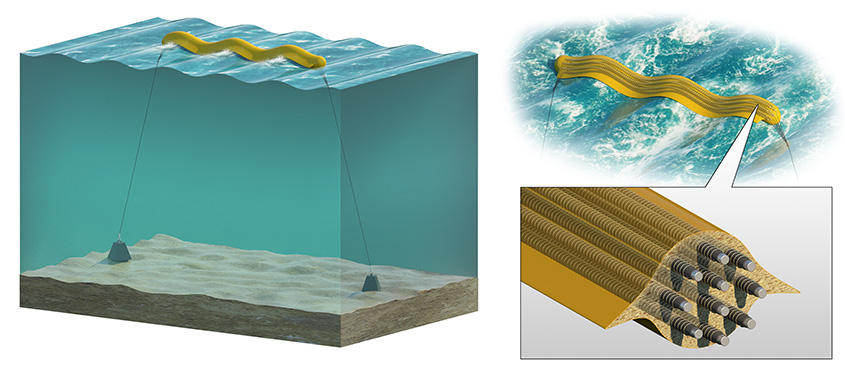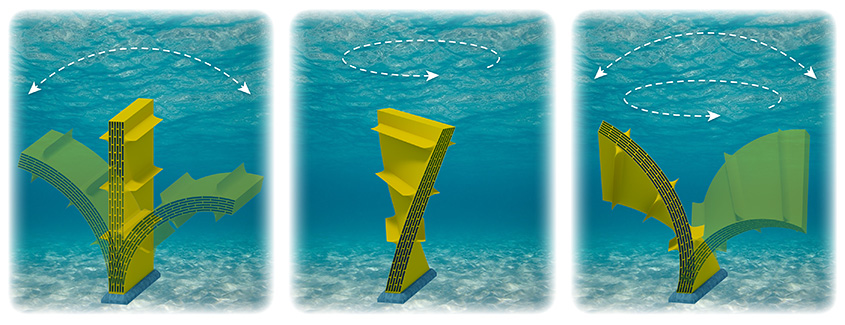New technology could potentially generate electricity from ocean waves, clothes, cars and even buildings
Imagine: clothing that charges your smartwatch as you walk, buildings that vibrate with the wind to power your lights, roads that extract energy from the friction caused by moving cars, in ocean waves. Flexible structures that change shape to generate clean electricity. For communities around the world.
This is not sci-fi. One day, we may be able to harness these naturally occurring energy sources thanks to the first technology domains we’ve just patented. It is a decentralized embedded energy conversion technology (or DEEC-Tec, pronounced Deck Tech for short).
The first patent for this invention is dedicated to marine renewable energy applications, clean electricity generated from ocean and river waves, currents and tides. However, DEEC-Tec has the potential to ultimately transform everyday energy sources, including nearly all physical movements and dynamic shape changes, into electricity or other usable energy.
“The DEEC-Tec domain has legs and is growing,” said Jochem Weber, Senior Engineer at the National Renewable Energy Laboratory (NREL) and Chief Engineer for NREL’s Hydropower Program, and the patent’s lead inventor. said Blake Boren, DEEC-Tec may have legs for buildings, clothing and roads, but it starts at sea. “This patent shows that we are gaining momentum in a fruitful area of research,” Bohlen said.
So how does this promising DEEC-Tec domain work in practice?
Imagine a sea snake. The snake is able to swim thanks to complex partnerships between many flexible muscle cells.In the DEEC-Tec domain, individual energy converters work together like muscle cells to create larger structures like sea snakes. increase. Most devices use a single generator to convert ocean energy into usable, clean, renewable sources of energy, such as electricity. However, DEEC-Tec collects many small converters to form one larger, often flexible energy converter.
“DEEC-Tec offers researchers and developers a whole new way of thinking about how to convert ocean energy from ocean waves, tides and currents into more usable forms of energy such as electricity.” Boren said.
These small energy converters can be combined to form the basis for fabrics, bulkheads, support structures, etc. to build a variety of DEEC-Tec based energy conversion structures. For example, a DEEC-Tec-based wave energy converter could look like a deflating and expanding balloon, a meandering serpent, or a paddle that twists and turns to harness ocean wave energy.
These adaptable balloons, snakes and paddles can also bring great benefits. Flexible wave energy converters, also called flexWEC, can utilize waves throughout the structure and convert them into usable energy. So wherever and how the wave energy interacts with the structure of the device, there is an energy converter there to convert that wave into electrical power.

flexWEC does not concentrate sea wave energy into a single energy converter (such as a single rotating generator or hydraulic piston-cylinder) or a single driveline system (such as a drive shaft or gearbox), thus potentially blocking or Avoids the build-up of ocean wave forces that can stop them. damage the machine. In fact, other wave energy converters often use large steel frames to protect their rigid bodies from ocean forces, but these frames can be expensive and heavy. Instead, flexWEC can go with the flow.
The FlexWEC frame can also make energy available from a much wider range of ocean locations and wave energy frequencies. “One day, there may be DEEC-Tec-based marine renewable energy farms off the coast of California, Oregon, or Washington. ,” said Boren.
High costs are one of the last major hurdles that a thriving ocean energy industry must overcome to start powering these communities. Also, the flexible prototype of DEEC-Tec may provide a particularly cost-effective way to harness wave energy. The flexWEC hosts multiple energy converters, potentially requiring fewer maintenance trips. If only a small group of small converters need to be fixed, all other converters can still work.
The FlexWEC can also be built using more sustainable and cost-effective materials, making it easier to install and control once it’s out to sea. Better control means increased energy production, allowing operators to adapt to changing ocean conditions and make the most of their energy potential.
The DEEC-Tec domain is still relatively new, so Boren and his team are working hard to explore exactly how these technologies can create new generations of ocean energy devices and other energy-producing materials. It is working. Boren’s recent patent also gives DEEC-Tec a big boost for the future.
“This patent gives us even more confidence in what DEEC-Tec could be,” said Boren. “We now have a patented foundation to further develop and promote DEEC-Tec, not only within NREL, but also with external collaborators and industry.”
Click here for details NREL’s Distributed Embedded Energy Converter Technology. When Subscribe to the NREL Hydropower newsletter, Current, Don’t miss out on the latest in hydropower.

